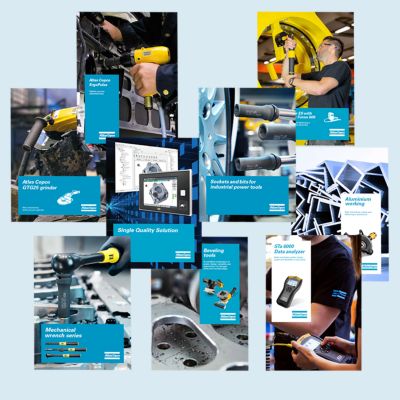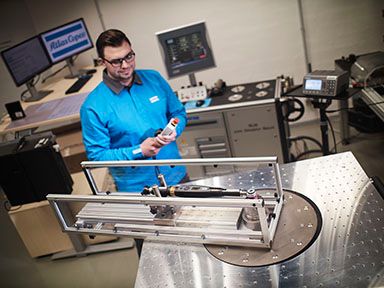More than 20% material savings is only one of the numerous advantages of stitch bead in comparison to a common bead application. Learn how you can push the productivity, safety and quality of your hybrid joining process to the next level – all while lowering your total cost of ownership.
At times of lightweight and multi-material design, hybrid joining is one of the major trends in automotive body shops. With hybrid joining, high-strength adhesives for structural bonding are combined with other joining technologies like spot welding, flow drill fastening or self-pierce riveting. This offers major benefits:
- Higher structural strength and stiffness improve driving properties and crash safety
- Improved corrosion resistance of the joint
- Due to high-strength adhesives, the number of weld spots can be reduced
 Squeeze-out of adhesive at weld spots
Squeeze-out of adhesive at weld spots
Challenges in hybrid joining
The combination of adhesive dispensing and other joining techniques poses many challenges. At welding or rivet spots, adhesive material can get squeezed out. This leads to material waste and rework. When used with spot welding, the adhesive is destroyed by the heat of the welding process, and this can lead to the emission of toxic fumes. On top of that, a higher welding current is required, and the system needs more time to weld through. Common error patterns:
 Blow-out: destroyed adhesive at weld spots
Blow-out: destroyed adhesive at weld spots
- Squeeze-out: At weld or rivet spots, adhesive material is squeezed out. This would contaminate the KTL bath and leads to rework and material waste.
- Blow-out: If the adhesive is detroyed in the heating process during spot welding, it can blow out. This can lead to corrosion and weak joints.
Problem solver stitch bead application

The stitch bead application generates material gaps in the area of the combustion circle at welding spots.
Atlas Copco offers an application pattern that is especially developed for hybrid joining to resolve these challenges. The so-called stitch bead is an interrupted application with defined material gaps at the weld areas that offers numerous benefits:
- Saves adhesive material and cost
- Precise application avoids rework caused by material squeeze-outs at the weld spots
- No toxic fumes when used with spot welding; air extraction systems no longer necessary
- Less adhesive means less weight, lowering CO2 emissions
Up to 22 % of material savings possible with a stitch bead solution
The potential material savings are huge. For example, using the calculation for a typical side panel application that has 54 spot welds at the front door entry and 44 weld spots at the back door entry for a total 98 weld spots. When you apply a common continuous bead of 3 mm diameter, the applied material volume is 38 ccm in total. When you apply a stitch bead with a gap of 12 mm, you save up to 0.0848 ccm of material per weld spot. With 98 weld spots, you save 8.3 ccm per side panel – this is a material saving of 22%.
 Material savings with stitch bead
Material savings with stitch bead
Savings potential - stitch bead application
| Calculation example | |
|---|---|
| Bead diameter | 3 mm |
| Adhesive gap | 12 mm |
| Material savings per spot: | 0.15 cm * 0.15 cm * 3.14 * 1.2cm = 0.0848 ccm |
| Material savings per side panel (98 weld spots): | 98 * 0.0848 ccm = 8.3 ccm |
| Material savings per car body: | 2*8.3 ccm = 16.6 ccm |
| Material savings per day (1000 car bodies): | 16.6 ccm * 1.355 g/ccm = 22.5 kg |
| Cost saving per day: | 22,5 kg * 14 €/kg = 315 € (side panels only) |
| Cost savings per year: | 315 € * 225 = ca. 70.875 € (side panels only) |
Challenges in the stitch bead application process: robot speed and flexibility
The advantages of stitch bead in hybrid joining are exceptional compared to common continuous bead applications. Nevertheless, there are significant challenges in the application process regarding robot speed and application flexibility. High volume production lines require robot speeds of up to 500 mm/s and more. At the same time, car geometries get more complex. Bead and gap sizes must be freely definable – and need to be applied precisely and reliably to the car part. But switching times between robot, system control and applicator delay the response of the valve needle that opens and closes the nozzle. This is where common application systems reach their limits.
 Relation of switching time and robot spead in stitch bead applications
Relation of switching time and robot spead in stitch bead applications
Example: required switching times at a robot speed of 350 mm/s:
- 34.2 ms at 12 mm application or gap
- 28.5 ms at 10 mm application or gap
- 22.8 ms at 8 mm application or gap
Teaching via robot control
In many industrial dispensing systems, the stitch bead has to be programmed via the robot controller, entering the bead length and gap length manually. The switching time must be matched with the robot speed, otherwise the length of the bead and the gaps are not equivalent to the mm specification. This requires a high programming effort, resulting in higher costs.
Realization via system control
Modern industrial adhesive dispensing systems from Atlas Copco´s SCA product line offer a special software for stitch bead applications. The bead and gap lengths can be entered directly into the application control system. The robot control only starts the application with the “applicator open” signal. The controller autonomously triggers the valve according to the specified bead and gap lengths and the robot speed. The feedback is performed via a position sensor and is included into the calculation. The robot programmer has only to control the application speed, start signal and the robot path. All other signals for the applicator are handled within the application control.
Benefits of software-based programming:
- Automated determination of switching times
- Exact triggering of the applicator valve
- High flexibility: Up to 128 sequences (bead and gap) are possible within one program
- Low programming effort and low risk of operator failure
Case example: High-speed stitch bead
An Asian automotive manufacturer decided to combine high-strength adhesive bonding with spot welding in the inner frame, floor frame, center tunnel, dashboard and wheel arch of a new car platform. The goal was to improve stiffness, crash-resistance and the overall driving experience. Internal investigation showed that the driving behavior of the car improved significantly using up to 50 meters of adhesive in the underbody. The stitch bead proved to be the application pattern best suited for this joining challenge. It enables a widespread distribution between the weld spots at the underbody group without exceeding the 70-meter optimum.
 High-speed pneumatic stitch bead applicator for heated and unheated materials.
High-speed pneumatic stitch bead applicator for heated and unheated materials.
The requirement of the OEM was a robot speed of at least 500 mm/s – without compromising the application quality and process reliability. For this client, Atlas Copco developed a special applicator to ensure a reliable high-speed process according to the customer specification. The solution is a pneumatic applicator with a double action cylinder and extremely fast switching air valves. To speed up the needle stroke, Atlas Copco redesigned and enlarged the valve openings. The air can escape more quickly when opening and closing the nozzle. Today, the Asian OEM runs more than 100 Atlas Copco systems in its body shop production line – and is already working with Atlas Copco to even further increase the robot speed.
Summary: Why you should invest in a stitch bead solution
The stitch bead is a true problem solver in hybrid joining, especially when combined with spot welding. With material savings up to 20%, significant cost savings can be achieved, along with many other advantages that boost your productivity, safety and quality – and reduce your total cost of ownership. But robot speed can be a challenge in the application process. Considering the high requirements coming from the industry, many common dispensing systems reach their limits. Atlas Copco has developed a special high-speed applicator to reliably perform robot speeds of 500 mm/s and more. At the same time, the dedicated software reduces programming efforts.
Learn more about our innovative adhesive dispensing solutions for body shop









